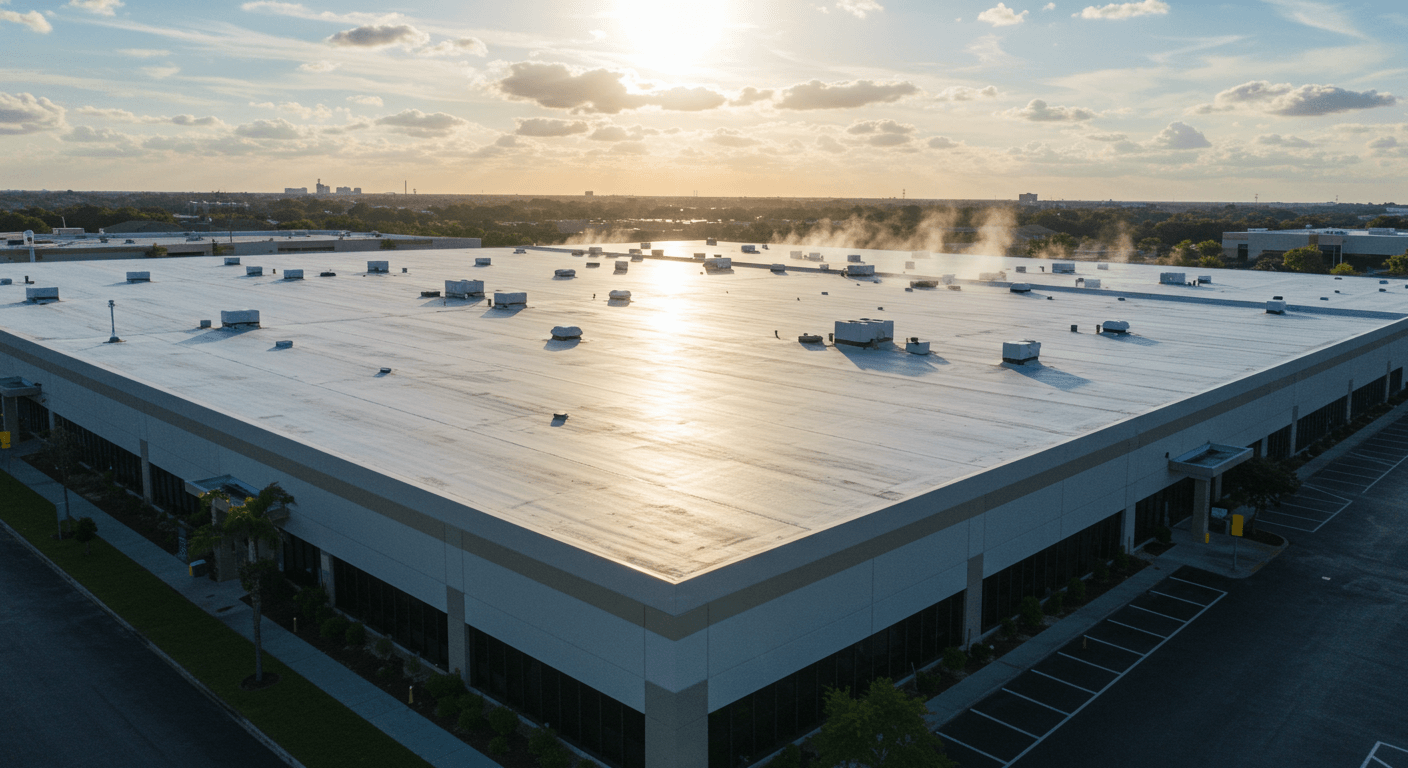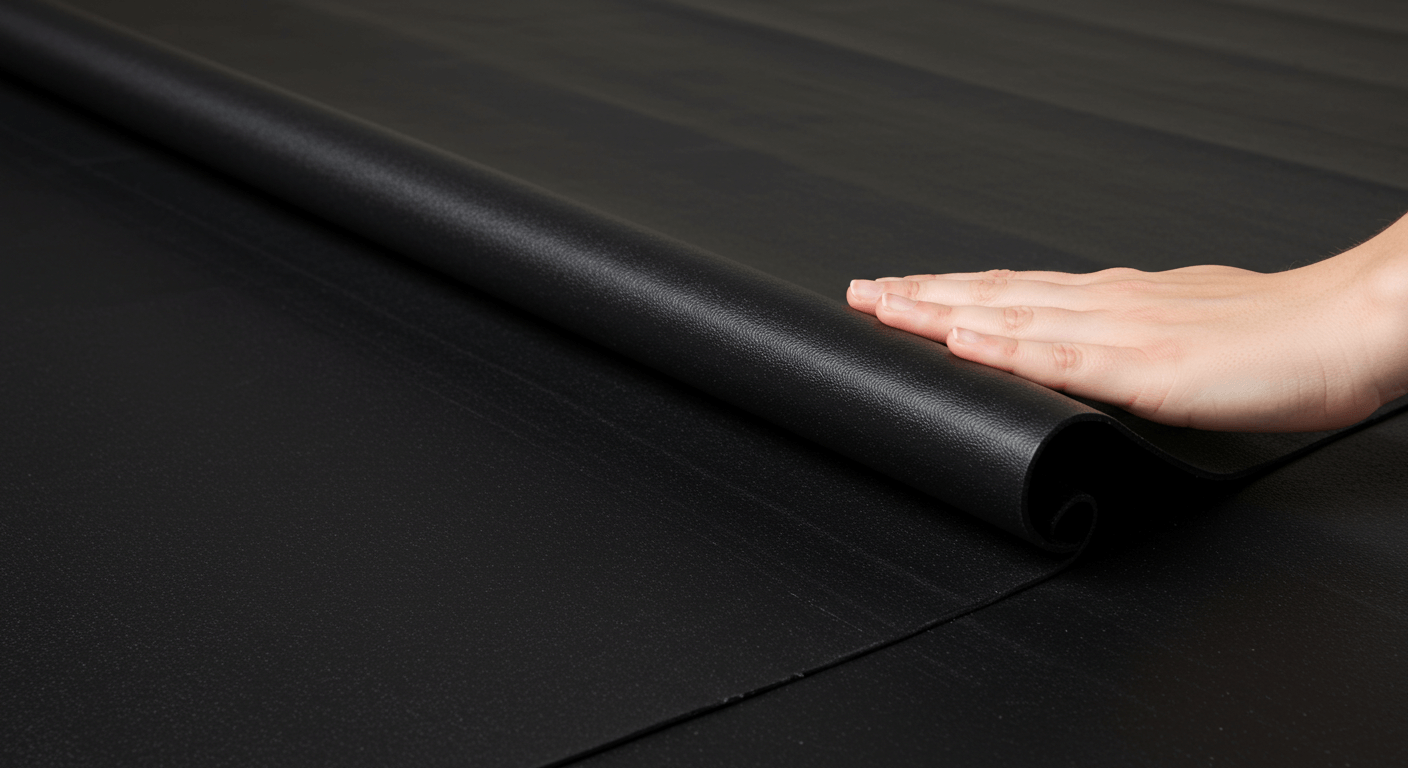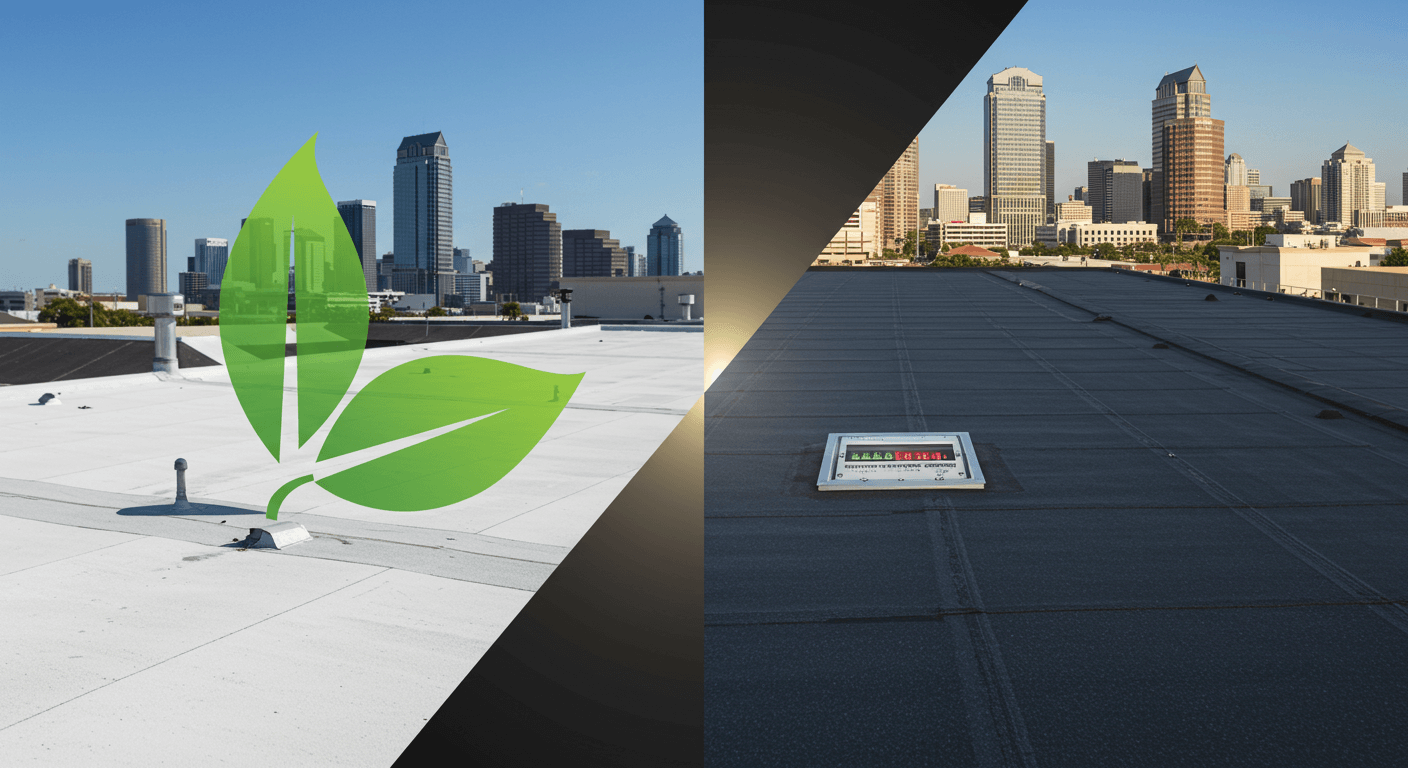Choosing the right roofing material for your Tampa commercial building can feel overwhelming. With Florida’s intense heat, sudden storms, and year-round humidity, your roof needs to handle serious weather challenges. Two of the most popular options for flat commercial roofs are TPO and EPDM membranes, but which one is right for your business?
If you’re trying to decide between these two roofing systems, you’re not alone. Many Tampa business owners face this same choice when it’s time for a roof replacement or new installation. Both materials have their strengths, but the best choice depends on your specific building, budget, and priorities.
Let’s break down everything you need to know about TPO vs EPDM roofing so you can make an informed decision for your Tampa commercial property.
Understanding TPO Roofing Systems

What is TPO Roofing?
TPO stands for Thermoplastic Polyolefin, which sounds complicated but is actually a straightforward roofing material. Think of it as a flexible plastic sheet that’s specifically designed to protect buildings from the elements. TPO membranes are typically white or light-colored, which helps reflect sunlight and keep buildings cooler.
This roofing system has gained popularity over the past 20 years because it combines the benefits of both rubber and plastic roofing materials. The result is a membrane that’s flexible enough to handle building movement but strong enough to resist punctures and tears.
TPO Performance in Tampa’s Climate

Tampa’s climate can be tough on commercial roofs. With average summer temperatures reaching the 90s and intense UV rays year-round, your roof takes a beating. TPO roofing performs well in these conditions for several reasons.
First, the white surface reflects most of the sun’s heat away from your building. This means your air conditioning doesn’t have to work as hard, which can lead to energy savings. The actual savings depend on your building size, insulation levels, and current energy costs, but many Tampa businesses notice a difference in their cooling expenses.
TPO also handles Tampa’s frequent storms well. Quality TPO systems can withstand strong winds when properly installed, and the heat-welded seams create a watertight barrier against heavy rains. Most TPO roofs last 15-20 years in Florida’s climate, making them a solid long-term investment.
TPO Installation Process
Installing TPO roofing requires specialized equipment and training. The installer uses hot air to weld the seams together, creating a single, continuous membrane across your entire roof. This welding process is crucial because it eliminates weak points where water could penetrate.
The installation typically takes several days for an average commercial building, depending on the size and complexity of your roof. Professional installation is essential because improper welding can lead to premature failure and void your warranty.
Understanding EPDM Roofing Systems

What is EPDM Roofing?
EPDM stands for Ethylene Propylene Diene Monomer, but most people just call it rubber roofing. This material has been protecting commercial buildings for over 50 years, making it one of the most proven roofing systems available.
EPDM comes in both black and white versions, though black is more common. The material is made from recycled materials, making it an environmentally friendly choice. Unlike TPO, EPDM feels more like a thick rubber mat than plastic sheeting.
EPDM Performance in Tampa’s Climate
EPDM has a long track record of success in Florida’s challenging climate. The rubber material naturally resists UV damage, ozone, and temperature extremes. Even after decades of exposure to Tampa’s intense sun, EPDM maintains its flexibility and protective qualities.
One advantage of EPDM is its ability to handle thermal cycling. When your roof heats up during the day and cools down at night, the material expands and contracts. EPDM’s rubber composition handles this movement better than most other roofing materials.
EPDM roofs typically last 20-25 years in Tampa’s climate, sometimes even longer with proper maintenance. The material’s durability and longevity have made it a favorite among building owners who want a “set it and forget it” roofing solution.
EPDM Installation Methods
EPDM can be installed using three different methods: ballasted, adhered, or mechanically attached. The choice depends on your building’s structure and local building codes.
In Tampa, most EPDM installations use the adhered method, where the membrane is glued directly to the roof deck. The seams are sealed using special tape or liquid adhesive rather than heat welding. This makes installation less dependent on weather conditions compared to TPO.
Head-to-Head Comparison for Tampa Buildings
Energy Efficiency & Cost Savings
When it comes to keeping your Tampa building cool, TPO has a clear advantage. The white, reflective surface can reduce surface temperatures significantly compared to traditional black roofing, which may translate to noticeable savings on your electric bill.
The actual energy savings depend on many factors, including your building size, insulation levels, HVAC efficiency, and current energy costs. A professional energy assessment can help estimate potential savings for your specific building.
However, white EPDM offers similar energy benefits to TPO. If energy efficiency is your main concern, either white TPO or white EPDM will serve you well. The key is choosing a light-colored, reflective surface regardless of the material.
Durability & Weather Resistance
Both materials handle Tampa’s weather well, but in different ways. TPO’s heat-welded seams create an incredibly strong bond that’s less likely to fail during hurricane-force winds. The seams are actually stronger than the membrane itself.
EPDM relies on adhesive or tape for seam sealing, which can be a weak point over time. However, EPDM’s rubber composition is naturally more flexible, so it’s less likely to crack or split from building movement or thermal cycling.
In terms of puncture resistance, both materials perform similarly. TPO is slightly more resistant to foot traffic damage, while EPDM is more forgiving if repairs are needed. Small punctures in EPDM can often be patched easily, while TPO repairs may require professional welding equipment.
Installation & Maintenance
TPO installation requires specialized training and equipment for heat welding. This means fewer contractors can install it properly, which might limit your options or affect costs. Weather conditions also affect TPO installation more than EPDM.
EPDM installation is generally more straightforward and less weather-dependent. More contractors are familiar with EPDM installation, which can mean competitive pricing and easier scheduling.
For maintenance, both systems are relatively low-maintenance. EPDM typically needs less frequent inspections because the material ages more predictably. TPO requires regular seam inspections to ensure the welded joints remain intact.
Cost Analysis
Installation costs for both TPO and EPDM vary significantly based on several factors. The size of your roof, complexity of the installation, current roof condition, and local market conditions all influence the final price.
Generally, TPO and EPDM fall into similar price ranges, though TPO installations might cost slightly more due to the specialized equipment and training required for proper heat welding. However, these differences depend heavily on your specific project details and the contractors you’re considering.
When evaluating costs, don’t focus only on the initial installation price. Consider the total cost of ownership over the roof’s entire lifespan, including potential energy savings, maintenance requirements, and expected replacement timing.
Which is Right for Your Tampa Commercial Building?

Choose TPO if:
Your building has high cooling costs and energy efficiency is a top priority. TPO makes sense for office buildings, retail centers, and other structures where people work during the day and air conditioning runs constantly.
TPO is also ideal if your building needs to meet specific energy codes or if you’re pursuing LEED certification. The reflective properties and potential energy savings make TPO attractive for green building projects.
Choose EPDM if:
You want proven, long-term performance with minimal maintenance. EPDM is perfect for warehouses, manufacturing facilities, and other buildings where energy costs are less critical than reliability.
EPDM also works well for buildings with complex roof shapes or numerous penetrations. The material’s flexibility makes it easier to work around obstacles and irregular surfaces.
Professional Assessment Needed
The truth is, the best choice depends on your specific situation. Factors like your building’s structure, insulation, HVAC system, and usage patterns all influence which material will perform better for you.
A professional commercial roof inspection can evaluate your current roof condition and help determine the best replacement option. During this assessment, experienced contractors can identify factors that might favor one material over another.
Working with Tampa Commercial Roofing Contractors
Choosing the right material is only half the battle. The installation quality matters just as much as the material choice. Look for contractors with specific experience in both TPO and EPDM installation, not just general roofing experience.
Ask potential contractors about their track record with each material in Tampa’s climate. A good contractor should be able to show you examples of both systems they’ve installed and explain why they recommended each material for specific buildings.
Make sure any contractor you choose is properly licensed and insured for commercial work in Florida. They should also offer manufacturer warranties on materials and workmanship warranties on installation.
Whether you need commercial roof installation or are considering a complete roof replacement, working with experienced professionals ensures you get the most from your investment.
Making Your Decision
Both TPO and EPDM offer excellent protection for Tampa commercial buildings when properly installed and maintained. TPO provides superior energy efficiency and modern installation techniques, while EPDM offers proven longevity and straightforward maintenance.
Your decision should be based on your building’s specific needs, your budget, and your long-term goals. Consider factors like energy costs, maintenance capabilities, and how long you plan to own the building.
Don’t make this decision alone. A professional evaluation of your building and roof can provide valuable insights that influence your choice. Contact experienced Tampa commercial roofing contractors to discuss your options and get detailed recommendations for your specific situation.
The right roofing choice will protect your business for decades while providing the performance and value you need. Take time to understand your options, get professional advice, and choose the system that best serves your Tampa commercial building’s unique requirements.
Ready to move forward with your roofing project? Explore our full range of commercial roofing services to see how we can help protect your business investment with the right roofing solution.
